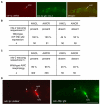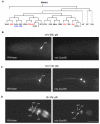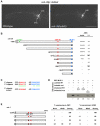The HMX/NKX homeodomain protein MLS-2 specifies the identity of the AWC sensory neuron type via regulation of the ceh-36 Otx gene in C. elegans
- PMID: 20150279
- PMCID: PMC2834459
- DOI: 10.1242/dev.044719
The HMX/NKX homeodomain protein MLS-2 specifies the identity of the AWC sensory neuron type via regulation of the ceh-36 Otx gene in C. elegans
Abstract
The differentiated features of postmitotic neurons are dictated by the expression of specific transcription factors. The mechanisms by which the precise spatiotemporal expression patterns of these factors are regulated are poorly understood. In C. elegans, the ceh-36 Otx homeobox gene is expressed in the AWC sensory neurons throughout postembryonic development, and regulates terminal differentiation of this neuronal subtype. Here, we show that the HMX/NKX homeodomain protein MLS-2 regulates ceh-36 expression specifically in the AWC neurons. Consequently, the AWC neurons fail to express neuron type-specific characteristics in mls-2 mutants. mls-2 is expressed transiently in postmitotic AWC neurons, and directly initiates ceh-36 expression. CEH-36 subsequently interacts with a distinct site in its cis-regulatory sequences to maintain its own expression, and also directly regulates the expression of AWC-specific terminal differentiation genes. We also show that MLS-2 acts in additional neuron types to regulate their development and differentiation. Our analysis describes a transcription factor cascade that defines the unique postmitotic characteristics of a sensory neuron subtype, and provides insights into the spatiotemporal regulatory mechanisms that generate functional diversity in the sensory nervous system.
Figures







Similar articles
-
Synergistic roles of homeodomain proteins UNC-62 homothorax and MLS-2 HMX/NKX in the specification of olfactory neurons in Caenorhabditis elegans.Genetics. 2021 Oct 2;219(2):iyab133. doi: 10.1093/genetics/iyab133. Genetics. 2021. PMID: 34849889 Free PMC article.
-
Otx/otd homeobox genes specify distinct sensory neuron identities in C. elegans.Dev Cell. 2003 Oct;5(4):621-33. doi: 10.1016/s1534-5807(03)00293-4. Dev Cell. 2003. PMID: 14536063
-
The Bicoid class homeodomain factors ceh-36/OTX and unc-30/PITX cooperate in C. elegans embryonic progenitor cells to regulate robust development.PLoS Genet. 2015 Mar 4;11(3):e1005003. doi: 10.1371/journal.pgen.1005003. eCollection 2015 Mar. PLoS Genet. 2015. PMID: 25738873 Free PMC article.
-
Brn3/POU-IV-type POU homeobox genes-Paradigmatic regulators of neuronal identity across phylogeny.Wiley Interdiscip Rev Dev Biol. 2020 Jul;9(4):e374. doi: 10.1002/wdev.374. Epub 2020 Feb 3. Wiley Interdiscip Rev Dev Biol. 2020. PMID: 32012462 Review.
-
A map of terminal regulators of neuronal identity in Caenorhabditis elegans.Wiley Interdiscip Rev Dev Biol. 2016 Jul;5(4):474-98. doi: 10.1002/wdev.233. Epub 2016 May 2. Wiley Interdiscip Rev Dev Biol. 2016. PMID: 27136279 Free PMC article. Review.
Cited by
-
Transmembrane protein OSTA-1 shapes sensory cilia morphology via regulation of intracellular membrane trafficking in C. elegans.Development. 2013 Apr;140(7):1560-72. doi: 10.1242/dev.086249. Development. 2013. PMID: 23482491 Free PMC article.
-
The homeodomain protein hmbx-1 maintains asymmetric gene expression in adult C. elegans olfactory neurons.Genes Dev. 2010 Aug 15;24(16):1802-15. doi: 10.1101/gad.1932610. Genes Dev. 2010. PMID: 20713521 Free PMC article.
-
Modular control of glutamatergic neuronal identity in C. elegans by distinct homeodomain proteins.Cell. 2013 Oct 24;155(3):659-73. doi: 10.1016/j.cell.2013.09.052. Epub 2013 Oct 24. Cell. 2013. PMID: 24243022 Free PMC article.
-
Sox2 goes beyond stem cell biology.Cell Cycle. 2016;15(6):777-8. doi: 10.1080/15384101.2015.1137714. Cell Cycle. 2016. PMID: 26743825 Free PMC article. No abstract available.
-
UNC-42 function is required for the ectopic expression of ASH markers in mls-2 mutant animals.MicroPubl Biol. 2019 Jun 12;2019:10.17912/micropub.biology.000116. doi: 10.17912/micropub.biology.000116. MicroPubl Biol. 2019. PMID: 32550438 Free PMC article. No abstract available.
References
-
- Alenina N., Bashammakh S., Bader M. (2006). Specification and differentiation of serotonergic neurons. Stem Cell Rev. 2, 5-10 - PubMed
-
- Alon U. (2007). Network motifs: theory and experimental approaches. Nat. Rev. Genet. 8, 450-461 - PubMed
-
- Altun-Gultekin Z., Andachi Y., Tsalik E. L., Pilgrim D., Kohara Y., Hobert O. (2001). A regulatory cascade of three homeobox genes, ceh-10, ttx-3 and ceh-23 controls cell fate specification of a defined interneuron class in C. elegans. Development 128, 1951-1969 - PubMed
-
- Amendt B. A., Sutherland L. B., Russo A. F. (1999). Transcriptional antagonism between Hmx1 and Nkx2.5 for a shared DNA-binding site. J. Biol. Chem. 274, 11635-11642 - PubMed
Publication types
MeSH terms
Substances
Grants and funding
LinkOut - more resources
Full Text Sources
Molecular Biology Databases
Research Materials

